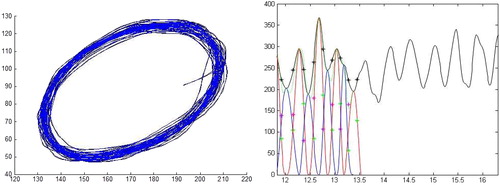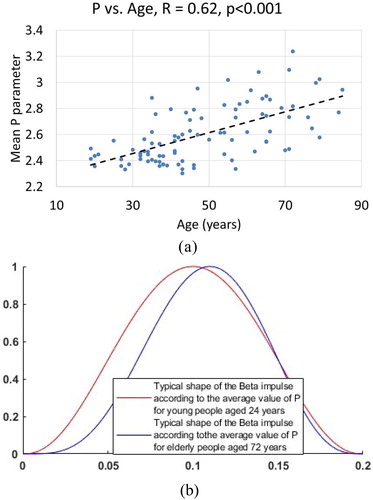 ?Mathematical formulae have been encoded as MathML and are displayed in this HTML version using MathJax in order to improve their display. Uncheck the box to turn MathJax off. This feature requires Javascript. Click on a formula to zoom.
?Mathematical formulae have been encoded as MathML and are displayed in this HTML version using MathJax in order to improve their display. Uncheck the box to turn MathJax off. This feature requires Javascript. Click on a formula to zoom.1. Introduction
In recent years, progress has been made in addressing the problem of hand movement features modelling based on the Beta elliptic model (Boubaker et al. Citation2015). Comparing snapshots of handwriting movements, hand drawing, and signatures executed by a same subject at spaced age intervals; adult and elderly, there is usually a tendency for rigidity and discontinuity in accomplished trajectories that expresses a growth of an impulsive character on both graphical and kinematic profiles (Plamondon Citation1995). In this framework, the objective of this work is to assess the range of trajectories parameters variation during a standardized ellipse drawing task in a sample of subjects with age ranging from 19 to 85 years. The determination of the spatiotemporal features of drawing trajectory trough the Beta elliptic model will allow to assess the normal range of parameter variation and the effect of age.
2. Methods
In order to study the effect of age on hand movement kinematics, The Beta elliptic model was chosen which is characterized by a rich output in terms of kinematical, graphical and biometrical data [1].
In fact, the Beta elliptic model is based on a combined representation modeling the velocity by a Beta functions and the trajectory by elliptic arcs. Each trajectory stroke corresponds in the velocity profile to the generation of one Beta impulse represented by the following expression:
with:
K is the amplitude of the Beta function.
t0, t1 and tc are the time instants corresponding to the starting time, the ending time of a Beta function and the instant when the generated impulse reaches its maximum value K respectively.
P and Q control the function width and symmetry. The generation of a complex hand movement velocity profile is the result of the algebraic sum of n overlapped Beta impulses as shown in the following expression:
A hand movement database from 92 participants, aged from 19 to 85 years, was gathered with the following age distribution: 33 subjects in the range [19, 39] years, 33 in the range [40, 59] and 26 subjects in the range [60, 85]. Thirty women (range 19-72 years) and sixty-two men (range 25-85 years) participated. During the data collection, each person was placed in a seated position and was asked to perform a repetitive tracing of an ellipse for 60 seconds on a tactile tablet with a stylus. The model of the ellipse was drawn on a sheet of paper placed on top of the tablet. A custom-made software developed in Matlab was used. A sampling rate of 100 Hz was used and the data were filtered with a Chebyshev low pass filter (second type) at a cut-off frequency of fcut =12Hz. The characteristics of the ellipse were: Long axis a = 60 mm, small axis b = 36 mm, inclination of the major axis θ = 30°. An application of the Beta elliptic model on an example of elliptical hand movement trajectory is illustrated in .
Figure 1. Beta elliptic model applied on one elliptic trajectory: Geometric representation and velocity profile modelled by overlapped Beta impulses.

Based on the Beta elliptic model, five parameters representing the kinematic characteristics of the drawing movement were extracted ().
Table 1. Extracted parameters from the ellipses.
3. Results and discussion
The values of the correlation coefficients between age and the parameters were: For P: r = 0.62, p < 0.001, SDP: r = 0.63, p < 0.001, RMax/min: r = 0.49, p < 0.001, SDRMax/min: r = 0.46, p < 0.001 and Nbr_imp: r = 0.51, p < 0.001. The experimental results showed a tendency of growth with age of the values of the parameters P, P-SD, RMax/min and Nbr_imp which indicate an increase of the number of impulses (the number of Beta functions necessary to reconstruct the velocity profile). A graphical representation of the parameter P controlling the width of the Beta impulses according to age and its linear regression is presented in . A comparison between two Beta impulses for two different subjects (24 years and 72 years) is depicted in .
Figure 2. (a) P vs. age. (b) Comparison between typical shapes of the Beta impulses between two subjects aged 24 years and 72 years.

The growth of the parameter P value with age observed in our experiment results which translate in finer and repetitive impulses can be explained by the increasing with elderly age of the neuromuscular channel response time that affects the aspect of the Beta impulses. Consequently, the nervous system may tend to increase the number and the amplitude of the impulses at the local maximums of curvature radius to compensate the delay caused by their width reduction. Therefore, the RMax/min ratio and the Nbr_imp parameters regain growth in the elderly age. The relatively low values of the two last correlation coefficients can be explained by the phase of almost stagnation of RMax/min and Nbr_imp parameters over the range of [19, 40].
4. Conclusions
This paper investigated the effect of age on hand movement kinematics during ellipse drawing. Five parameters representing the kinematic characteristics were analysed in a sample of 92 subjects with age ranging from 19 to 85 years. The examination of the experimental results confirmed the validity, throughout this age range, of the main kinematics models leading the hand movement curvilinear velocity as its overlapped Beta impulses shape. Also, the qualitative assessment of the extracted parameters showed that the parameter P (and its SD) controlling the shape of the Beta functions modelling the neuromuscular pulses vary on average according to the age, while the ratio of the amplitudes of successive velocity impulses and their average number are relatively stable on young and adult age and grow only for elderly age from 50 years.
Additional information
Funding
References
- Boubaker H, Rezzoug N, Kherallah M, Gorce P, Alimi A.M. 2015. Spatiotemporal representation of 3D hand trajectory based on beta-elliptic models. Comp. Methods Biomech Biomed Eng. 18(15):1632–1647.
- Plamondon R. 1995. A kinematic theory of rapid human movements. Biol Cybern. 72(4):295–307.
